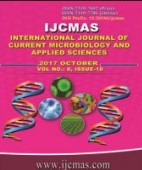


 National Academy of Agricultural Sciences (NAAS)
National Academy of Agricultural Sciences (NAAS)

|
PRINT ISSN : 2319-7692
Online ISSN : 2319-7706 Issues : 12 per year Publisher : Excellent Publishers Email : editorijcmas@gmail.com / submit@ijcmas.com Editor-in-chief: Dr.M.Prakash Index Copernicus ICV 2018: 95.39 NAAS RATING 2020: 5.38 |
Pseudomonas aeruginosa producing Metallo-B-Lactamase (MBL) is emerging as a serious threat in the treatment of patients. Early and promt detection of the same will help in timely implication of infection control measures and appropriate treatment. This study was taken up to compare the different phenotypic methods in the detect MBL producing Pseudomonas aeruginosa from pus samples. Only those isolates with pure and predominant growth of P. aeruginosa obtained from pus samples were included in the study. Four different phenotypic methods were used to test the MBL production in those isolates of P. aeruginosa which showed resistance to Imepenem – a) Imipenem (IMP) - EDTA combined disc test. b) Imipenem (IMP) - EDTA double disc synergy test. c) EDTA disc potentiation using Ceftazidime, Ceftizoxime and Cefotaxime. d) Modified Hodge test. A total of 1200 pus sample screened, of which 90 P. aeruginosa isolates were isolated. Out of the 90 P. aeruginosa isolated from pus samples, 66(73.3%) were Imipenem sensitive and 24(26.6%) were resistant. Of the 24 P. aeruginosa resistant to Imipenem, IMP-EDTA CDT detected 14(58%) of ESBL producers, IMP-EDTA DDST detected 7(29%), EDTA disc potentiation test detected 11(46%) and Modified Hodge method detected 8(33%). And 2 (8.33%) did not show MBL production property by any of the four methods used in the study.100% sensitivity was noted to Colistin and Polymixin B in all the MBL harboring P. aeruginosa. Thus according to this study it was found that IMP- EDTA combined disc test has better detection rate of MBL producing P. aeruginosa, which can be easily incorporated in routine laboratory procedures.
 |
 |
 |
 |
 |